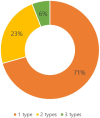The Research Trends of Pharmacopuncture Therapy on Cervical Pain Caused by Traffic Accidents
- PMID: 33408896
- PMCID: PMC7772081
- DOI: 10.3831/KPI.2020.23.4.201
The Research Trends of Pharmacopuncture Therapy on Cervical Pain Caused by Traffic Accidents
Abstract
Objectives: The purpose of this study is to comprehensively review Korean domestic studies and investigate the research trends of pharmacopuncture therapy on cervical pain caused by traffic accidents.
Methods: Domestic studies between February 1999 and May 2020 from four Korean databases were searched with combinations of keywords 'cervical pain', 'traffic accident', 'whiplash injury', and 'pharmacopuncture'.
Results: 17 studies were selected for review, including 7 randomized controlled trials, 5 retrospective observational studies, 3 case reports, and 2 non-randomized controlled trials. Each study was reviewed by published year, study type, types of pharmacopuncture solutions, selected acupuncture points, dosage of pharmacopuncture solutions, frequency of treatment, concurrent treatments, outcome measurements, and the effectiveness of pharmacopuncture therapy. The results are as follows (1) It showed that the total number of published studies had increased slightly in the last 10 years compared to the previous decade. (2) The pharmacopuncture solutions used in the studies were in the following order Bee-Venom (), Jungsongouhyul (), Hwangryunhaedoktang () and Soyeom (). Frequently used acupuncture points were GB20, GV21, A-shi point, GV16, EX-B2, and SI15 in order. (3) The most commonly used total injection dosage was 1.0 cc at a time, and the frequency of treatment was twice a week. (4) Concurrent treatments such as acupuncture, herbal medication, physical therapy and Chuna manual therapy were performed in all 17 studies. (5) Pharmacopuncture therapy showed positive effects on cervical pain caused by traffic accidents in all 17 studies reviewed.
Conclusion: Pharmacopuncture therapy was effective in cervical pain caused by traffic accidents in all 17 studies selected. Further studies will be needed using more larger scales and more objective data to confirm the effectiveness of pharmacopuncture therapy and to generalize its application.
Keywords: cervical pain; pharmacopuncture; traffic accident; whiplash injury.
© 2020 Korean Pharmacopuncture Institute.
Conflict of interest statement
CONFLICT OF INTEREST The authors declare that there is no conflict of interest.
Figures






References
-
- Road Traffic Authority [Internet] Traffic Accident Analysis System (TAAS); Wonju: 2020. [cited 2020 Aug 27]. Available from: http://taas.koroad.or.kr/sta/acs/exs/typical.do?menuId=WEB_KMP_OVT_UAS_ASA.
-
- Yoon IJ, Oh MS, Song TW. Clinical analysis of 112 cases of traffic accident patients. J Orient Rehabil Med. 1998;8(1):317–32.
-
- Shin HR, Park KT, Yang MH, Kim YB, Yeom SR, Kwon YD. A survey on satisfaction for Korean medicine treatments in 237 traffic injury patients. J Korean Med Rehabil. 2018;28(3):1246–1368. doi: 10.18325/jkmr.2018.28.3.67. - DOI
-
- The Korean Orthopaedic Association, author. Orthopaedics. 7th ed. ChoiSin Medical Publishing Co.; Seoul: 2013. pp. 67–78.
-
- Korean Pharmacopuncture Institute Science Committee, author; Pharmacopuncture Medicine Laboratory, author. Pharmacopuncturology. 2nd ed. Elsevier Korea; Seoul: 2011. pp. 1–32.pp. 93–115.
Publication types
LinkOut - more resources
Full Text Sources
